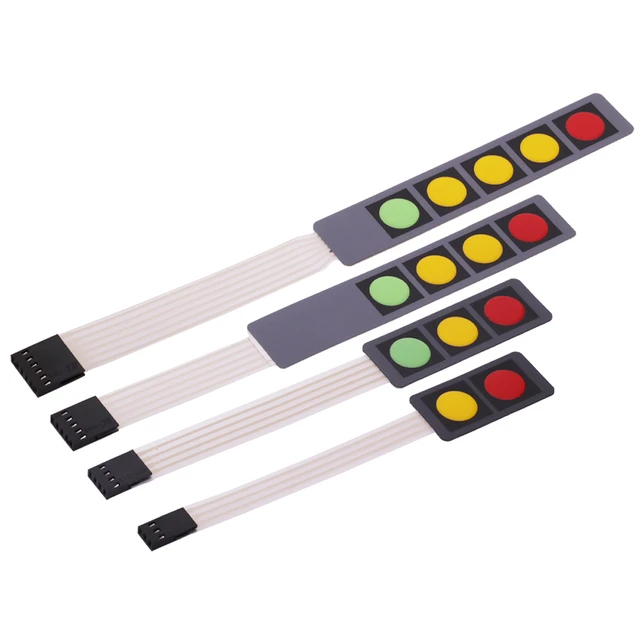Recognizing Membrane Changes: The Key to Reliable and long lasting Controls

What Are Membrane Switches?
Membrane switches are an advanced remedy in the world of interface technology, integrating performance and style effortlessly. These devices work as an interface between users and electronic systems, integrating numerous components into a portable layout. Generally constructed from versatile, thin layers of materials, membrane layer buttons are created to react to touch, enabling users to connect with equipment and digital gadgets successfully.
The key elements of a membrane button consist of a printed circuit layer, graphic overlay, and a spacer layer that prevents unintentional activation. The graphic overlay can be customized to reflect brand name identification or individual preferences, boosting aesthetic appeals while guaranteeing usability. Membrane buttons are typically utilized in numerous applications, including medical tools, consumer electronics, and commercial tools, owing to their toughness and resistance to ecological elements such as moisture and dirt.
Among the essential advantages of membrane layer switches is their capability to endure wear and tear, making them ideal for high-traffic environments. Furthermore, they are light-weight and call for marginal room, permitting innovative layouts in product development. On the whole, membrane layer switches represent a efficient and useful selection for contemporary electronic user interfaces, marrying technology with user-centric design principles.
Exactly How Membrane Layer Switches Over Job
The operation of membrane switches over hinges on a simple yet efficient mechanism that converts user input right into digital signals. When a customer presses the button, the leading layer deforms, allowing a conductive element in the circuit layer to make call with an equivalent conductive pad on the underside of the visuals overlay.
The style of membrane layer switches can vary, however they frequently include domes or responsive components to supply comments to the user, boosting the general experience - membrane switch. The products used in membrane layer switches, such as polyester or polycarbonate, add to their toughness and resistance to ecological factors, consisting of dampness and dirt. Additionally, the printed circuits are normally enveloped, which secures them from damage in time.
Advantages of Membrane Layer Switches

Furthermore, membrane buttons are recognized for their toughness. Constructed from robust materials, they are immune to dirt, moisture, and physical wear, which considerably prolongs their life expectancy contrasted to typical mechanical switches. This durability makes them particularly ideal for high-traffic atmospheres and applications calling for longevity.
One more considerable benefit is the ease of cleansing and maintenance. The smooth surface area of membrane switches reduces dust accumulation and is often invulnerable to spills, making them excellent for setups that call for constant sanitization.
Furthermore, membrane layer switches supply a structured profile, bring about a thinner layout that can be incorporated right into different gadgets without adding mass. This function not just boosts the aesthetic appeal yet also adds to a more ergonomic product layout.
Applications of Membrane Buttons
Versatile and straightforward, membrane switches find applications throughout a wide variety of industries, including clinical devices, customer electronics, and industrial devices. In the clinical field, these buttons are integral to gadgets such as diagnostic devices, individual monitoring systems, and infusion pumps, where reliability and convenience of cleaning are crucial. Their capacity to maintain and withstand harsh settings capability makes them suitable for such applications.

In customer electronic devices, membrane switches are used in items like microwaves, cleaning makers, and remote controls - membrane switch. Their smooth design enables intuitive interface, improving the overall user experience while giving toughness and resistance to deterioration
Commercial devices additionally benefits from membrane buttons, specifically in control panels for machinery and automation systems. These buttons supply defense versus dust and dampness, making certain regular performance in challenging environments. Their personalized functions permit makers to tailor them to particular functional needs, enhancing performance page and performance.
Picking the Right Membrane Switch
When choosing a membrane layer switch, it is important to think about different factors that influence performance and viability for certain applications. The key factors to consider consist of environmental conditions, responsive feedback, longevity, and layout requirements.
First, assess the operating click over here atmosphere; switches revealed to dampness, chemicals, or severe temperature levels need particular products to ensure long life and functionality. Next off, evaluate the requirement for tactile comments. Depending upon user interaction, some applications may benefit from a tactile feedback to verify activation, while others may favor a non-tactile layout for visual reasons.
Longevity is one more crucial aspect; membrane buttons must be developed to endure frequent use, influences, and abrasion. Make certain the chosen switch can endure the expected lifecycle, specifically in high-usage scenarios.

Conclusion
Finally, membrane switches act as essential components in the design of resilient and dependable control systems throughout various markets. Their compact style, integrated with robust building and adjustable functions, enhances individual interaction while making sure durability popular environments. The versatility of membrane layer changes permits tailored remedies that satisfy specific functional demands, strengthening their relevance in modern technology. As sectors continue to develop, the importance of incorporating reliable membrane switch options can not be overstated.
Membrane layer switches over stand for a crucial element of modern-day interface design, blending functionality with strength in various applications.Membrane layer buttons are a sophisticated option in the realm of customer interface technology, integrating functionality and design perfectly. Normally created from flexible, thin layers of products, membrane buttons are designed to react to touch, enabling users to connect with equipment and digital gadgets successfully.
The layout of membrane switches can differ, however they usually include domes or tactile components to supply comments to the customer, boosting the general experience.In verdict, membrane switches serve as important elements in the layout of trusted and resilient control systems across different industries.